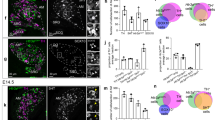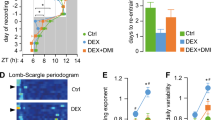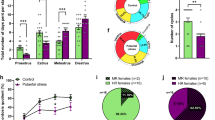Abstract
THE hormonal milieu in the neonatal period has profound influences on the morphological, biochemical and functional development of the brain1,2. Krieger reported that the administration of corticosteroid (dexamethasone or hydrocortisone) to 2–4-d-old rats suppressed the circadian rhythm of plasma corticosterone at 30 d of age3, whereas treatment at 12–14 d of age did not affect the rhythmicity. We have investigated whether the suppression of corticosterone rhythm results in its permanent derangement throughout adult life or merely indicates its delayed appearance. After this paper was submitted, Krieger published the results of a similar study4.
This is a preview of subscription content, access via your institution
Access options
Subscribe to this journal
Receive 51 print issues and online access
$199.00 per year
only $3.90 per issue
Buy this article
- Purchase on Springer Link
- Instant access to full article PDF
Prices may be subject to local taxes which are calculated during checkout
Similar content being viewed by others
References
Schaprio, S., in Influence of Hormones on the Nervous Systems (edit. by Ford, D. H.), 63–73 (S. Karger, Basel, 1971).
Vernadakis, A., and Woodbury, D. M., ibid., 85–97.
Krieger, D. T., Science, 178, 1205–1207 (1972).
Krieger, D. T., Neuroendocrinology, 16, 355–363 (1974).
Givner, M. L., and Guy Rochefort, J., Steroids, 6, 485–489 (1965).
Davidson, J. M., Jones, L. E., and Levine, S., Endocrinology, 82, 655–662 (1968).
Krieger, D. T., in Biological Rhythms and Endocrine Function (edit. by Hedlund, L. W., Franz, J. M., and Kenny, A. D.), 169–184 (Plenum, New York, 1975).
Gibbs, F. P., Am. J. Physiol., 219, 288–292 (1970).
Critchlow, V., Lieberlt, R. A., Bar-Sela, M., Moutcastle, W., and Lipscomb, H. S., Am. J. Physiol., 205, 807–815 (1963).
Ramaley, J. A., Steroids, 20, 185–197 (1972).
Ramaley, J. A., Steroids, 21, 597–608 (1973).
Kitay, J. I., in Functions of The Adrenal Cortex (edit. by McKerns, K. W.), 775–811 (Appleton–Century–Crofts, New York, 1968).
Hiroshige, T., Abe, K., Wada, S., and Kaneko, M., Neuroendocrinology, 11, 306–320 (1973).
Barraclough, C. A., in Neuroendocrinology (edit. by Martini, L., and Ganong, W. F.), 61–99 (Academic, New York, 1967).
Author information
Authors and Affiliations
Rights and permissions
About this article
Cite this article
MIYABO, S., HISADA, T. Sex difference in ontogenesis of circadian adrenocortical rhythm in cortisone-primed rats. Nature 256, 590–592 (1975). https://doi.org/10.1038/256590a0
Received:
Accepted:
Issue Date:
DOI: https://doi.org/10.1038/256590a0
Comments
By submitting a comment you agree to abide by our Terms and Community Guidelines. If you find something abusive or that does not comply with our terms or guidelines please flag it as inappropriate.



